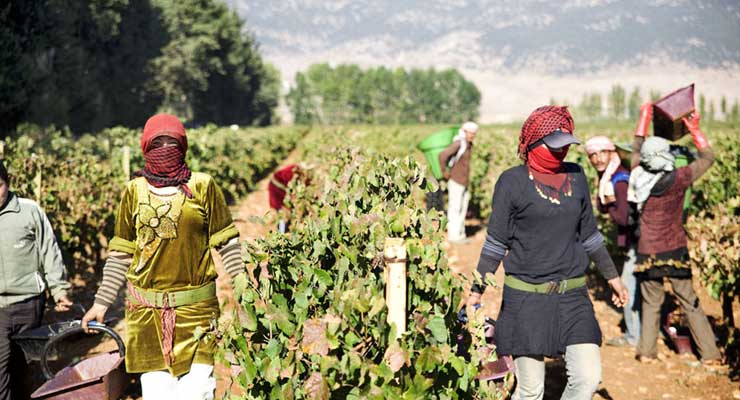http://mtv.com.lb/Programs/minal Every night right before the News, Albert Thoumy brings us facts and advice on a new topic related to our daily lives. You can send your inquiries and remarks on minal@mtv.com.lb
Best Seller – 18/03/2018 – Part 1
http://mtv.com.lb/Programs/Best_Seller
قتل عنصر بحزب الله
#USK 17/3/2018 – قتل عنصر بحزب الله www.lbcgroup.tv
علم وخبر – 17/03/2018
http://mtv.com.lb/Programs/3elm w Khabar
#USK 16-3-2018 شو في بين الأمم المتحدة وحزب الله؟
www.lbcgroup.tv

Iranian Oil Minister Bijan Namadar Zanganeh talks with Iranian journalist after signing an oil field agreement in Tehran on March 14, 2018. Iran’s state-run oil company has signed a $740 million agreement with a Russian-Iranian consortium to develop two oil fields. / AFP / ATTA KENARE
Reuters
Advertisement
http://www.dailystar.com.lb//Business/Regional/2018/Mar-15/441634-irans-zanganeh-says-opec-unlikely-to-change-output-deal-this-year.ashx
Women account for half the farming labor force
FAO finds a 43 percent payment gap
Women represent around 43 percent of the agricultural labor force, according to the Food and Agriculture Organization (FAO). The numbers were released on the occasion of International Women’s Day.
FAO’s figures also indicated that only nine percent of farms are headed and operated by women, and only five percent of agricultural land is cultivated by women.
Raphael Debbane, Head of Agricultural Committee at the Federation of the Chamber of Commerce, Industry, and Agriculture in Lebanon, said: “Women working in agriculture are more productive than men. They have large capabilities and are very serious.”
Many households in remote areas such as Akkar and Bekaa rely on female farmers to survive.
Debbane said that micro credit companies sometimes prefer to provide loans for women working in industries related to agriculture to allow them to update their machinery.
According to the FAO, female farmers are paid 43 percent less than men. Their average wage per day ranges between $15 and $20, according to Debbane.
“Women can play a bigger role in agriculture, and in using technology,” said Debbane.
Reported by Rania Ghanem
Date Posted: Mar 12, 2018
http://feedproxy.google.com/~r/BusinessnewscomlbRSS/~3/seZAeT5jdX0/StoryDetails.aspx
The size of the fruit juice industry ranges between $130 and $150 million, according to a recent study by BLOMInvest, “Can fruit juices keep the doctor away?”
One liter of juice costs on average $1.20 which translates into a volume for the juice market in the range of 108 to 125 million liters.
There are three main players, in addition to other producers and a niche market player. They are Liban Jus, SMLC (the agent of Pepsico), and Interbrand. Other players include Junet Juice, Kassatly Chtaura, Cedar’s, Liban Lait, Super Jus Chtaura, Rawabi, and Paradice.
The niche market player, Balkis, has different manufacturing techniques and uses different raw materials. The company targets consumers who prefer juices made from fresh fruits rather than from concentrates.
Producers of fruit juices are very competitive and tend to differentiate themselves by relying mainly on branding. Libby’s, Tropicana, and Candia are brands produced ‘under license’, which means that their sales could be boosted because of the reputation of the multinational companies they represent.
Others rely on the strength of their distribution channels and points of sale. Ralph Chartouni, Sales, Marketing and Logistics Manager of Interbrand, said “Fruit juices tend to be consumed on-the-go, which makes small retailers as well as groceries in remote areas our main target clients.”
Fruit juices come in three types: Premium, mainstream, and affordable. For example, Liban Jus offers three brands: Maccaw (premium), Uno (mainstream) and Top Juice (affordable).
Other producers like Kassatly and Junet, limit their provision to one juice brand. Kassatly, for example, manufactures Fruitastic.
Juice producers import around $5.9 million worth of pineapple and orange concentrates alone. According to Customs, around 4,800 tons of fruit juices worth $8.7 million were imported in 2017, of which 34 percent were pineapple concentrate, and 13 percent were mixed fruit concentrate.
Only $2.2 million worth of juice is exported, mainly to Arab and African countries. Qatar is the number one importer, with 28 percent of the total.
Chartouni said: “The main trends that impact local industries propagate to the country mainly from Europe. Therefore, the two strong trends of healthier choices and lower calorie foods will probably shape the direction of the juice industry in the coming years.”

Omari Mosque
creamsicle sunset
hey tiffany! posted a photo:
We enjoyed a dramatic sunset with a view of the Saida Sea Castle, which may have caused us to miss a bus back to Beirut.


